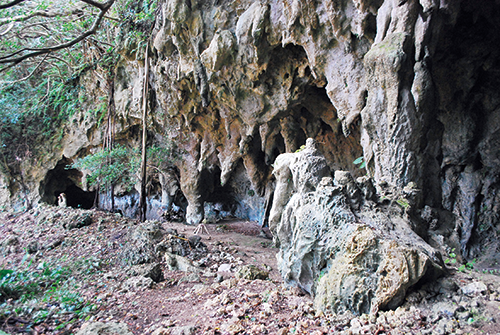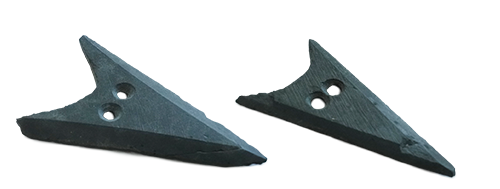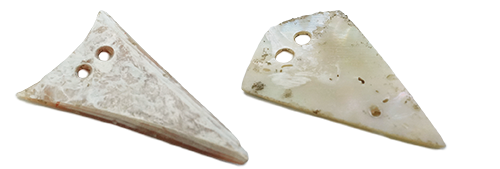Amagi Town, Kagoshima Prefecture
Incipient Phase, Jōmon to the Early Shell Mound Phase 3 periods (approximately 15,000–4,000 years ago)
A cave opening at a terrace scarp Myriad limestone caverns spread over the terrace scarp like the mesh of a net, and the Shitabaru Cave Site is formed at the entrance to a doline (a cavity created by the collapse of a cavern roof).
Linear relief pottery A total of 14 items were recovered. When carbonized material collected from the bottom of the layer in which they were found was radiocarbon dated, a result of 13,820 ± 40 BP (uncalibrated) was obtained. Width (from the left): 3.4 cm; 4 cm; 6.1 cm.
Distant view of the site (from the west) The western portion of the island of Tokunoshima has a marine terrace formed with two tiers of Ryūkyū limestone as its base, and the Shitabaru Cave Site is located at a scarp 60 m in height at the border of the terrace face.
Polished stone arrowheads Length (from the left): 4 cm; 3.4 cm.
Shell arrowheads Two holes were made in the same manner as for the polished stone arrowheads, and it is highly likely that these were manufactured by the same process as the stone arrowheads. Length (from the left): 3.5 cm; 3.6 cm.
First discovery in the Amami Islands of the oldest (“linear-relief”) pottery
Results pushing back the origins of pottery in the Amami Islands
The Shitabaru Cave Site is located in the western part of the island of Tokunoshima, lying to the south of Amami Ōshima Island. The cave is at the base of a terrace scarp about 500 m from the coast, with its mouth opening at an elevation of approximately 90 m. The cave’s entrance is about 33 m wide by 5 m high, but its inward extent is comparatively shallow, around 20 m even at the deepest point. Since 2016, when Kagoshima Women’s College and the Amagi Town Board of Education jointly started excavating with the aim of discovering buried prehistoric skeletal remains, noteworthy results have come forth one after another.
Particularly worth noting among these, from strata below a layer which yielded nail-impressed pottery of the southern island style which had until then been regarded as the oldest ceramic in the Amami Islands, previously unknown pottery assemblages were recovered, such as deep bowls or vase-shaped items decorated with wavy incised lines, or bowls with inward curing shapes. From strata further beneath these, linear-relief pottery of the Incipient phase of the Jōmon period was recovered, which had not been found south of the island of Tanegashima, making it certain that the origin of ceramic culture in the Amami Islands goes back 10,000 years or more. This gives proof that the use of pottery began in the Amami Islands at roughly the same time as on the Japanese mainland.
The site has strata that are older still, and when carbonized material found in those levels was radiocarbon dated, it yielded a result of 25,000 years before the present. This corresponds with the Paleolithic period, but no human artifacts have yet been found from this layer. The history of human culture of the Amami Islands is not well understood, and from future investigations facts rewriting that history may be obtained.
A polished stone arrowhead workshop is discovered
At the Shitabaru Cave Site, together with nail-impressed pottery of the southern island style there were many polished stone arrowheads found. These are made of slate which forms outcrops on the coast near the site, with flakes taken from the layers then worked with fine percussion into triangular shapes, after which the entire item is polished, and finally, two holes are made. Apart from the 108 examples of polished stone arrowheads recovered thus far, 298 items that were discarded in the process of manufacture have been unearthed. As stone drills and polishing stones thought to have been used in their manufacture have been found, as well as stone blocks to serve as working platforms, it is believed that polished stone arrowheads were manufactured at this location. There are also shell arrowheads made in the same shape as the polished stone items, and it is seen that the two types were used together.
In this manner it is a rare site where it may be possible to clarify the transition from the Paleolithic to the Jōmon periods of the Amami Islands. Please continue to look forward to the survey results. (Gushiken Ryō)






